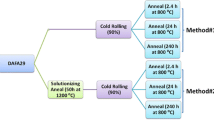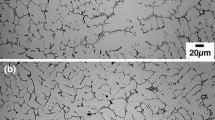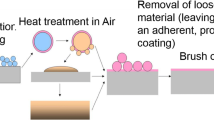Abstract
A new family of alumina-forming austenitic stainless steels is under development at Oak Ridge National Laboratory for structural use in aggressive oxidizing environments at 600–900°C. Data obtained to date indicate the potential to achieve superior oxidation resistance compared to conventional Cr2O3-forming iron-and nickel-based heat-resistant alloys, with creep strength comparable to state-of-the-art advanced austenitic stainless steels. A preliminary assessment also indicated that the newly developed alloys are amenable to welding. Details of the alloy design approach and composition-microstructure-property relationships are presented.
Similar content being viewed by others
References
M.P. Brady et al., “Alumina-Forming Austenitics: A New Class of Heat-Resistant Stainless Steels,” Stainless Steel World Magazine (March 2008), pp. 23–29.
Y. Yamamoto et al., Science, 316(5823) (2007), pp. 433–436.
Y. Yamamoto et al., Met. Mater. Trans. A, 38A(11) (2007), pp. 2737–2746.
M.P. Brady et al., Scripta Mater., 57(12) (2007), pp. 1117–1120.
Y. Yamamoto et al., Intermetallics, 16(3) (2008), pp. 453–462.
M.P. Brady et al., Materials Science Forum 2008 (in press).
Y. Yamamoto et al., to be submitted to Acta Materialia.
G.Y. Lai, High Temperature Corrosion of Engineering Alloys (Materials Park, OH: ASM International, 1990).
B. Gleeson, Corrosion and Environmental Degradation, Volume II, ed. M. Schutze, Materials Science and Technology Series (Weinheim, Germany: Wiley-VCH, 2000), chapter 5, pp. 173–228.
P. Kofstad, editor, High Temperature Corrosion (London: Elsevier, 1988).
M.P. Brady et al., Corrosion and Environmental Degradation, Volume II, ed. M. Schutze, Materials Science and Technology Series (Weinheim, Germany; Wiley-VCH, 2000), chapter 6, pp. 229–325.
J. Doychak, Intermetallic Compounds: Principles and Practice Vol. 1, ed. J.H. Westbrook and R.L. Fleischer (New York: John Wiley & Sons, 1994), pp. 977–1016.
G.H. Meier, Materials and Corrosion, 47(11) (1996), pp. 595–618.
G. Welsch et al., Oxidation and Corrosion of Intermetallic Alloys, ed. G. Welsch and P.D. Desai (West Lafayette, IN: Purdue Research Foundation, 1996), pp. 121–266.
G.J. Yurek, Corrosion Mechanisms, ed. F. Mansfeld (New York: Marcel Dekker, Inc., 1987), pp. 398–446.
E.J. Opila, Mat. Sci. Forum, 461–464 (2004), pp. 765–773.
B.A. Pint, R. Peraldi, and P.J. Maziasz, Mat. Sci. Forum, 461–464 (2004), p. 815.
P.J. Maziasz et al., International Journal of Hydrogen Energy, 32(16) (2007), pp. 3622–3630.
F.G. Wilson, B.R. Knott, and C.D. Desforges, Met. Mater. Trans. A, 9(2) (1978), pp. 275–282.
T. Fujioka et al., U.S. patent 3,989,514 (1976).
J.A. McGurty, “Austenitic Iron Alloys,” U.S. patent 4,086,085 (25 April 1978).
J.C. Pivin et al., Corr. Sci., 20 (1980), pp. 351–373.
V. Ramakrishnan, J. A. McGurty, and N. Jayaraman, Oxid. Met., 60 (1988), pp. 185–200.
F.H. Stott, G.C. Wood, and J. Stringer, Oxid. Met., 44(1–2) (1995), pp. 113–145.
C. Wagner, Corros. Sci., 5 (1965), pp. 751–764.
P.J. Maziasz, JOM, 41(7) (1989), pp. 14–20.
R.W. Swindeman et al., “Evolution of Advanced Austenitic Alloys Relative to Alloy Design Criteria for Steam Service: Part 1—Lean Stainless Steels,” Oak Ridge Natl. Lab. Rep. ORNL-6629/P1 (Oak Ridge, TN, 1990).
J.P. Shingledecker et al., Proc. ECCC Conference on Creep and Fracture in High Temperature Components—Design and Life Assessment Issues (Lancaster, PA: DEStech, 2005), pp. 99–109.
Allegheny Ludlum, TECHNICAL DATA BLUE SHEET, Stainless Steels, types 321, 347 and 348 (Pittsburgh, PA: ATI Allegheny Ludlum Corp., 2003), www.alleghenyludlum.com.
E. Essuman et al., Oxid. Met., 69(3–4) (2008), pp. 143–162.
I. Kvernes, M. Oliveira, and P. Kofstad, Corr. Sci., 17 (1997), pp. 237–252.
Author information
Authors and Affiliations
Corresponding author
Additional information
Author’s Note: Part of this research summary is based on a recent review paper (see Reference 1) and findings first reported in References 2–7.
Rights and permissions
About this article
Cite this article
Brady, M.P., Yamamoto, Y., Santella, M.L. et al. The development of alumina-forming austenitic stainless steels for high-temperature structural use. JOM 60, 12–18 (2008). https://doi.org/10.1007/s11837-008-0083-2
Published:
Issue Date:
DOI: https://doi.org/10.1007/s11837-008-0083-2




